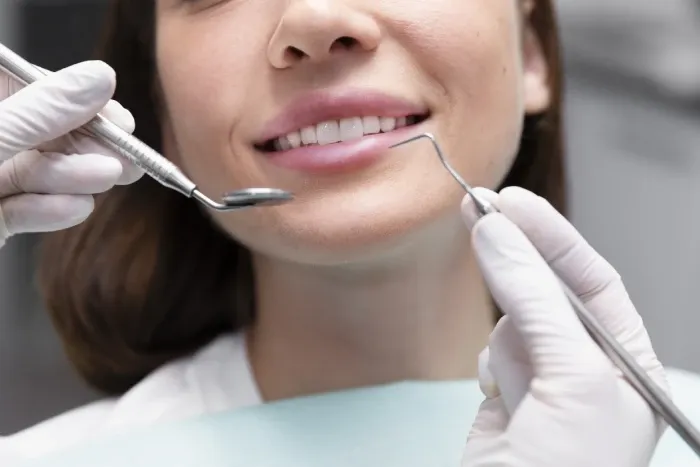These two fields of dentistry are both distinct and complementary. While both aim to enhance the aesthetic appearance of teeth, they use different treatment approaches and techniques. Smile design and aesthetic dentistry combine dental applications to meet both the aesthetic and functional needs of patients. However, each has its unique treatment methods, processes, and focus areas. In this article, we will explore the differences between these two branches of dentistry, what they entail, and when they should be preferred. Additionally, we will provide a comprehensive perspective on how treatments in these areas address individuals' aesthetic and functional needs. This will help you gain a clearer understanding of which treatment method is more suitable and which field is ideal for specific cases.
What is Smile Design? When is it Applied?

Smile design is a personalized approach aimed at providing individuals with a perfect smile in both aesthetic and functional aspects. This process considers the harmony of teeth, gums, lips, and facial features. The design is based on several factors, including the shape, size, color, and alignment of teeth. It is a comprehensive process that integrates various dental techniques to achieve a visually appealing smile.
Situations where smile design may be applied include:
- Tooth discoloration or staining: Yellowing or stains on teeth can be bothersome. Whitening treatments or porcelain laminates can correct this issue.
Irregular tooth shape and size: Shape irregularities or size discrepancies in teeth can create aesthetic problems. These can be corrected with reshaping or veneers. - Gaps between teeth: Excessive gaps between teeth can cause aesthetic concerns. Orthodontic treatments or composite fillings can close these gaps.
- Gum appearance: Excessive or insufficient gum visibility can negatively impact the aesthetics of teeth. Gum contouring can enhance the smile.
- Misalignment of teeth: Outward- or inward-facing teeth and other alignment issues are also addressed in smile design treatments.
What is Aesthetic Dentistry? What Treatments Does It Include?
Aesthetic dentistry includes treatment methods aimed at improving the appearance of teeth while maintaining their functional health. This field of dentistry enhances dental aesthetics without compromising oral and dental health. Treatments in this field are typically applied to improve a person’s smile, offering aesthetic solutions without negatively impacting oral health.
Aesthetic dentistry treatments include:
- Teeth Whitening: This procedure, applied to remove stains or yellowing, can make teeth several shades whiter.
- Porcelain Veneers: Used to correct the shape and color of teeth, porcelain veneers are particularly preferred for front teeth.
- Dental Implants: Replacing missing teeth with implants provides the most natural-looking solution.
- Composite Fillings: Used for treating cavities, composite fillings blend with the natural tooth color, offering a more aesthetic result.
- Porcelain Laminates: Thin porcelain layers placed on the front surfaces of teeth help alter their shape and color.
- Orthodontic Treatment (Braces): Aligning the teeth properly enhances the overall aesthetic appearance.
Smile Design or Aesthetic Dentistry: Which One is More Suitable?
Smile design and aesthetic dentistry are two different treatment approaches, yet they complement each other. Determining which one is more suitable depends on an individual's needs and expectations.
Smile Design is more suitable when:
The goal is to create a fully personalized smile by harmonizing teeth, gums, lips, and facial features.
There are significant irregularities, shape deformities, or color changes in the teeth that require comprehensive aesthetic correction.
A major aesthetic transformation is desired. Since it involves detailed analyses and planning, the treatment process can take longer.
Aesthetic Dentistry is more suitable when:
The teeth are generally healthy, but minor aesthetic improvements are needed.
Procedures such as teeth whitening, small fillings, or porcelain veneers are required for specific improvements.
A shorter treatment process is preferred since aesthetic dentistry involves less invasive procedures.
While aesthetic dentistry and smile design have different focuses in enhancing a smile, they are two complementary treatment approaches. Smile design offers a more comprehensive, personalized approach that aligns the teeth, gums, and facial features, whereas aesthetic dentistry provides specific treatment options for quick and effective results. Depending on your needs and expectations, both methods can offer effective solutions. After a detailed evaluation with your dentist, you can determine which treatment method is most suitable for you.
For more detailed information about teeth whitening, you can read articles in our "Aesthetic Dentistry" category or click the link to find the most suitable dental clinic for you. Visit our blog for more information about dental health.